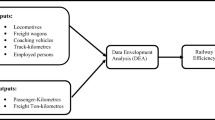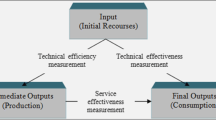Abstract
This paper proposes a novel network data envelopment analysis (NDEA) approach to measure both technical efficiency and service effectiveness of railway transportation services. In particular, railway transportation systems consume varying amounts of shared inputs to produce outputs. The proposed NDEA model represents both the non-storable feature of transportation service and production technologies in a unified framework in the presence of shared inputs. Hence, the proposed model not only measures the overall efficiency of the railways, but also estimates passenger and freight technical efficiency, service effectiveness, and technical effectiveness, simultaneously. A case study validates the proposed model.



Similar content being viewed by others
References
André, F.J., Herrero, I., Riesgo, L.: A modified DEA model to estimate the importance of objectives with an application to agricultural economics. Omega 38(5), 371–382 (2010)
Avkiran, N., McCrystal, A.: Sensitivity analysis of network DEA: NSBM versus NRAM. Appl. Math. Comput. 218(22), 11226–11239 (2012)
Avkiran, N.K., Morita, H.: Benchmarking firm performance from a multiple-stakeholder perspective with an application to Chinese banking. Omega 38(6), 501–508 (2010)
Azadi, M., Farzipoor Saen, R.: Developing a new chance-constrained DEA model for suppliers selection in the presence of undesirable outputs. Int. J. Oper. Res 13(1), 44–66 (2012)
Azadi, M., Farzipoor Saen, R., Tavana, M.: Supplier selection using chance-constrained data envelopment analysis with non-discretionary factors and stochastic data. Int. J. Ind. Syst. Eng. 10(2), 167–196 (2012)
Banker, R., Charnes, A., Cooper, W.W.: Some models for estimating technical and scale inefficiencies in data envelopment analysis. Manag. Sci. 30(9), 1078–1092 (1984)
Chang, Y.-T., Zhang, N., Danao, D., Zhang, N.: Environmental efficiency analysis of transportation system in China: a non-radial DEA approach. Energy Policy 58, 277–283 (2013)
Charnes, A., Cooper, W.W., Rhodes, E.: Measuring the efficiency of decision making units. Eur. J. Oper. Res. 23(1), 429–444 (1978)
Chen, Y., Cook, W.D., Li, N., Zhu, J.: Additive efficiency decomposition in two-stage DEA. Eur. J. Oper. Res. 196(3), 1170–1176 (2009)
Chiou, Y.C., Lan, L.W., Yen, B.T.H.: A joint measurement of efficiency and effectiveness for non-storable commodities: intenerated data envelopment analysis approaches. Eur. J. Oper. Res. 201(2), 477–489 (2010)
Cook, D., Zhu, J., Bi, G., Yang, F.: Network DEA: additive efficiency decomposition. Eur. J. Oper. Res. 207(2), 1122–1129 (2010)
De Nicola, A., Gitto, S., Mancuso, P.: Uncover the predictive structure of healthcare efficiency applying a bootstrapped data envelopment analysis. Expert Syst. Appl. 39(12), 10495–10499 (2012)
Farzipoor Saen, R.: Supplier selection by the pair of nondiscretionaryfactors-imprecise data envelopment analysis models. J. Oper. Res. Soc. 60(11), 1575–1582 (2009)
Fielding, G.J.: Managing Public Transit Strategically. Jossey-Bass, San Francisco (1987)
Fukuyama, H., Mirdehghan, S.M.: Identifying the efficiency status in network DEA. Eur. J. Oper. Res. 220(1), 85–92 (2012)
Graham, D.J.: Productivity and efficiency in urban railways: parametric and non-parametric estimates. Transp. Res. E Logist. Transp. Rev. 44(1), 84–99 (2008)
Heidari, M.D., Omid, M., Mohammadi, A.: Measuring productive efficiency of horticultural greenhouses in Iran: a data envelopment analysis approach. Expert Syst. Appl. 39(1), 1040–1045 (2012)
Hirschhausen, C.V., Cullmann, A.: A nonparametric efficiency analysis of German public transport companies. Transp. Res. E Logist. Transp. Rev. 46(3), 436–445 (2010)
Jitsuzumi, T., Nakamura, A.: Causes of inefficiency in Japanese railways: application of DEA for managers and policymakers. Socio Econ. Plan. Sci. 44(3), 161–173 (2010)
Kao, C., Hwang, S.N.: Efficiency decomposition in two-stage data envelopment analysis: an application to non-life insurance companies in Taiwan. Eur. J. Oper. Res. 185(1), 418–429 (2008)
Khodakarami, M., Shabani, A., Farzipoor Saen, R.: Concurrent estimation of efficiency and effectiveness and returns to scale. Int. J. Syst. Sci. (in press)
Liang, L., Cook, W.D., Zhu, J.: DEA model for two-stage processes: game approach and efficiency decomposition. Nav. Res. Logist. 55(1), 643–653 (2008)
Lin, E.T.J.: Route-based performance evaluation of Taiwanese domestic airlines using data envelopment analysis: a comment. Transp. Res. E Logist. Transp. Rev. 44(5), 894–899 (2008)
Lin, R.C., Sir, M.Y., Pasupathy, K.S.: Multi-objective simulation optimization using data envelopment analysis and genetic algorithm: specific application to determining optimal resource levels in surgical services. Omega 41(5), 881–892 (2013)
Liu, J.S., Lu, L.Y.Y., Lu, W.M., Lin, B.J.Y.: A survey of DEA applications. Omega 41(5), 893–902 (2013)
Meng, W., Zhang, D., Qi, L., Liu, W.: Two-level DEA approaches in research evaluation. Omega 36(6), 950–957 (2008)
Montoneri, B., Lee, C.C., Lin, T.T., Huang, S.L.: A learning performance evaluation with benchmarking concept for English writing courses. Expert Syst. Appl. 38(12), 14542–14549 (2011)
Puri, J., Yadav, S.P.: A concept of fuzzy input mix-efficiency in fuzzy DEA and its application in banking sector. Expert Syst. Appl. 40(5), 1437–1450 (2013)
Raab, R., Lichty, R.W.: Identifying sub-areas that comprise a greater metropolitan area: the criterion of county relative efficiency. J. Reg. Sci. 42(3), 579–594 (2002)
Samoilenko, S., Osei-Bryson, K.-M.: Using data envelopment analysis (DEA) for monitoring efficiency-based performance of productivity-driven organizations: design and implementation of a decision support system. Omega 41(1), 131–142 (2013)
Tavassoli, M., Faramarzi, G.R., Farzipoor Saen, R.: A joint measurement of efficiency and effectiveness for the best supplier selection using integrated data envelopment analysis approach. Int. J. Math. Oper. Res. 6(1), 70–83 (2014)
Tavassoli, M., Faramarzi, G.R., Farzipoor Saen, R.: Efficiency and effectiveness in airline performance using a SBM-NDEA model in the presence of shared input. J. Air Transp. Manag. 34, 146–153 (2014)
Yu, M.M.: Assessing the technical efficiency, service effectiveness, and technical effectiveness of the world’s railways through NDEA analysis. Transp. Res. A 42(10), 1283–1294 (2008)
Yu, M.M., Lin, E.T.J.: Efficiency and effectiveness in railway performance using a multi-activity network DEA model. Omega 36(6), 1005–1017 (2008)
Acknowledgments
Authors would like to thank four anonymous Reviewers for insightful comments and suggestions.
Author information
Authors and Affiliations
Corresponding author
Rights and permissions
About this article
Cite this article
Tavassoli, M., Faramarzi, G.R. & Saen, R.F. A joint measurement of efficiency and effectiveness using network data envelopment analysis approach in the presence of shared input. OPSEARCH 52, 490–504 (2015). https://doi.org/10.1007/s12597-014-0188-z
Accepted:
Published:
Issue Date:
DOI: https://doi.org/10.1007/s12597-014-0188-z




